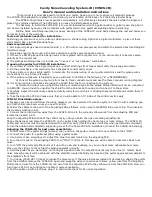
StamoLys CA 71 SI
Installation
Hauser
11
3.3
Installation instructions
To install the analyzer at the intended location, proceed as follows:
1.
Place the analyzer in position and secure it to a wall using M6 screws, if necessary.
For the installation dimensions, please see previous chapter.
2.
Use a spirit level to check that the cabinet is standing or hanging level. This is the
only way to ensure that any air bubbles that occur can escape from the cell.
3.
Place the edge covers on the analyzer edges (with GFK housing only).
4.
Lay the drain pipe for the reaction products. Where possible, use fixed pipes (PVC
or PE, internal diameter ¾ " with 3% incline).
5.
Insert the valve hoses according to Fig. 9. This prevents the hoses becoming stuck
or being pressed against the same position for a long period of time.
C07-CA71xxx-00-08-00-xx-007.eps
Fig. 9:
Valves and valve hoses
V1
Valve 1
V2
Valve 2
1
To the pump
2
Y-piece, connecting hose to valve 1, behind it
3
Hose valve 2, front, standard
4
Hose valve 2, back, cleaning agent
5
Hose valve 1, front, sample
6.
Secure the hose cassettes in the pump brackets:
Sample pump on the left, reagent pump on the right. Here, the flow direction of
sample and reagent must be anticlockwise.
7.
Connect the sample transfer.
!
Note!
The sample can be obtained as follows:
– Directly or after a reversible flow filter or a cross current filter by means of a small
pump (rating approx. 300 ml/min), suitable for clear media, e.g. in the discharge
channel of a sewage treatment plant
– From a sedimentation tank or after microfiltration; this is practical for media
containing flocculants,
e.g. in an activated sludge basin
– Sample conditioning using ultrafiltration for heavily soiled media,
e.g. from the primary settling tank
For questions regarding sample conditioning and its automation, please contact
Hauser Service or the
Hauser Sales Centre responsible for your region.
1
2
3
4
5
V1
V2
Содержание Stamolys CA71CL
Страница 2: ......












































